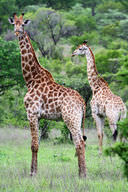10.22 哺乳动物分类
Section outline
-
To what group do rats belong?
::老鼠属于哪个群体?Rats are mammals , but this class can be divided into more specific groups. Rats are in a group known as rodents. Rodents are gnawing animals that include beavers, mice, and squirrels.
::鼠是哺乳动物,但这一类可以分为更具体的组别。 鼠属于被称作鼠类的组别。 鼠是食肉动物,包括海狸、小鼠和松鼠。Groups of Mammals
::哺乳动物群体Traditionally, mammals were divided into groups based on their characteristics. Scientists took into consideration their anatomy (body structure), their habitats , and their feeding habits. Mammals are divided into three subclasses and about 26 orders. Some of the groups of mammals include:
::科学家考虑到他们的解剖学(身体结构)、栖息地和喂养习惯。-
Lagomorphs
include hares and rabbits. Rabbits and hares characteristically have long ears, a short tail, and strong hind limbs that provide for a bouncing method of
locomotion
. They are all are small to medium-sized
herbivores
.
::野兔和野兔通常长耳朵、短尾和强后肢,提供摇晃的跳动方法。 它们都是中小食草动物。 -
Rodents
include rats, mice, and other small gnawing mammals. They have a single pair of continuously growing incisors (teeth) in each of the upper and lower jaws that must be kept short by gnawing.
::鼠类包括大鼠、小鼠和其他小咬性哺乳动物。 它们在每个上下下下下下下巴都有一对持续生长的切口(牙),必须被咬短。 -
Carnivores
include cats and lions and tigers, dogs and wolves, polar bears, and other meat eaters.
::食肉动物包括猫、狮子、老虎、狗、狼、北极熊和其他食肉动物。 -
Insectivores
include moles and shrews (
Figure
). These mammals eat primarily
, other
, and
earthworms
.
::这些哺乳动物主要吃、吃其他和蚯蚓。
One of the subgroups of mammals is the insectivores, including this shrew.
::哺乳动物的一个分组是昆虫,包括这个精细。-
Bats
include the vampire bat. These mammals have forelimbs that form webbed wings, making bats the only mammals naturally capable of true and sustained flight.
::蝙蝠包括吸血鬼蝙蝠。这些哺乳动物有形成网状翅膀的,使蝙蝠成为唯一能够真正和持续飞行的哺乳动物。 -
include monkeys, apes and humans. These mammals are characterized by detailed development of the hands and feet, a shortened snout, and a large
brain
.
::这些哺乳动物的特征是手脚的细细发育、短鼻子和大大脑。 -
Ungulates
include hoofed animals, such as deer, sheep, goats, pigs, buffalo, elephants and giraffes (
Figure
). These mammals use their hoofs to sustain their whole body weight while moving. Hoofs are formed by a thick nail rolled around the tip of the toe.
::这些哺乳动物在移动时用它们的蹄子维持整个体重。 蹄子是用一个厚厚的钉子在脚尖上滚动而成的。
The ungulates (hoofed animals), like the giraffe here, is one of the subgroups of mammals.
::象这里的长颈鹿一样的动物是哺乳动物的亚群之一。Mammals can also be grouped according to the adaptations they form to live in a certain habitat. For example, terrestrial mammals with leaping kinds of movement, as in some marsupials and lagomorphs, typically live in open habitats. Other terrestrial mammals are adapted for running, such as dogs or horses. Still others, such as elephants, hippopotamuses, and rhinoceroses, move slowly. Other mammals are adapted for living in trees, such as many monkeys ( Figure ). Others live in water, such as manatees, whales, dolphins, and seals. Still others are adapted for flight, like bats.
::哺乳动物也可以根据它们形成的适应性来分类,以便生活在某个生境中。例如,具有飞跃运动种类的陆地哺乳动物,如一些哺乳动物和花岗动物,通常生活在开放的生境中。其他陆地哺乳动物,如狗或马,也适应于运行。还有一些哺乳动物,如大象、河马、犀牛等,移动缓慢。其他哺乳动物则适应于生活在树木中,如许多猴子(Figure ) 。其他哺乳动物则生活在水中,如甲壳动物、鲸鱼、海豚和海豹。还有一些哺乳动物则适应于飞行,如蝙蝠。This howler monkey shows adaptations for life among the trees.
::这只叫声猴子在树上展示了 生命的适应性Summary
::摘要-
Traditionally, mammals were divided into groups based on their anatomy (body structure), their habitats, and their feeding habits.
::传统上,哺乳动物根据其解剖学(身体结构)、栖息地和喂养习惯分为几组。 -
Subgroups of the mammals include rodents, carnivores, insectivores, bats, and primates.
::哺乳动物的分组包括鼠类、食肉动物、昆虫、蝙蝠和灵长类动物。
Explore More
::探索更多Use the resources below to answer the questions that follow.
::利用以下资源回答以下问题。Explore More I
::探索更多-
Mammal Conservation in Island Ecosystems
at
(5:21)
::5:21时岛屿生态系统哺乳动物养护(5:21)
-
What is the average size of a mammal?
::哺乳动物的平均尺寸是多少? -
What groups of mammals are most abundant?
::哪些类哺乳动物最丰富? -
How often does Dr. Healey find new species in his work?
::Healey博士在他的作品中 多久发现新物种? -
How does the diversity of bats compare to the diversity of other mammals in the Philippines? What does this tell you about generalized statements about species diversity?
::蝙蝠的多样性与菲律宾其他哺乳动物的多样性相比如何?
Explore More II
::探索更多情况二-
Platypus Parts
at
(3:44)
::3:44时(3:44)的板板块部件
-
Where does the platypus (
Ornithorhynchus anatinus
) live?
::白喉(Ornithohhynchus anatinus)住在哪里? -
What do platypus eat?
::白喉会吃什么? -
How do platypus look for food?
::白化石如何寻找食物? -
What is the purpose of the "spur" on males?
::"扫荡"对男性的目的是什么?
Review
::回顾-
What are rodents? Give two examples.
::鼠类是什么?请举两个例子。 -
What are characteristics of primates. Give three examples of primates.
::灵长类的特征是什么。 请举三个灵长类的示例 。 -
What are ungulates? Give four examples.
::是什么?请举四个例子。 -
List five examples of carnivores.
::列举五例食肉动物。
-
Lagomorphs
include hares and rabbits. Rabbits and hares characteristically have long ears, a short tail, and strong hind limbs that provide for a bouncing method of
locomotion
. They are all are small to medium-sized
herbivores
.



